Lou’s Views
News & Views / May Edition
Calendar of Events –

Blue Crab Festival
May 20th & 21st
Little River SC
Little River has been celebrating the World Famous Blue Crab Festival since 1981. It is held on the waterfront in Little River and is one of the largest festivals in the Southeast. The purpose of this festival is one that supports and showcases the fabulous atmosphere of the local communities.
For more information » click here

Riverfest Celebration
June 24th
Conway SC
Held along the Waccamaw River in downtown Conway the festival celebrates Independence Day with music and events for the entire family.
For more information » click here

N.C. 4th of July Festival
July 4th
Southport
The patriotic spirit of America is alive and well in the City of Southport. For over 200 years this small maritime community has celebrated our nation’s independence in a big way. Incorporated as the N.C. 4th of July Festival in 1972 the festival committee strives to keep the focus of the festival on honoring our nation’s birthday with a little fun thrown in.
For more information » click here

Battleship Blast 4th of July Celebration
July 4th
Wilmington
Annual 4th of July Celebration at Riverfront Park in downtown Wilmington. Featured entertainment will perform from 6:00 PM to 9:00 PM, followed by fireworks at 9:05 PM launched from a barge in the Cape Fear River adjacent to the USS North Carolina Battleship. The only place you need to be this holiday is downtown Wilmington for the best view of fireworks.
For more information » click here
 Discover a wide range of things to do in the Brunswick Islands for an experience that goes beyond the beach.
Discover a wide range of things to do in the Brunswick Islands for an experience that goes beyond the beach.
For more information » click here.
Calendar of Events Island –
 Concerts on the Coast Series
Concerts on the Coast Series
The Town’s summer concert series calendar has been released! Live performances featuring local musical groups are held at the pavilion on Sunday evenings from late May to early September. The concerts are free of charge.
For more information » click here

Tide Dyed Program
This event is located at the Holden Beach Pavilion. Tie dye your own shirts; the cost is just $7 per shirt. It takes place between 1:00 to 2:30 p.m. every Tuesday during the summer.
.
.
Beginning June 13th and continuing through August 8th
with no program the week of July 4th
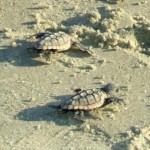 Turtle Talk
Turtle Talk
Two programs both are held every Wednesday during the summer at Town Hall. Children’s Turtle Time is at 4:00 p.m. with crafts, stories and activities for children ages 3 – 6. All children must be accompanied by an adult. Turtle Talk is an educational program at 7:00 p.m. for everyone else. (Beginning June 28th)
Parks & Recreation / Programs & Events
For more information » click here
Reminders –

Pets on the Beach Strand
Pets – Chapter 90 / Animals / 90.20
From May 20th through September 10th it is unlawful to have any pet on the beach strand during the hours of 9:00am through 5:00pm.

A Second Helping
.
Program to collect food Saturday mornings (8:00am to 10:30am) during the summer at the Beach Mart on the Causeway.
1) Nineteenth year of the program
2) Food collections have now exceeded 290,000 pounds
3) Collections will begin on Memorial Day weekend
4) Food is distributed to the needy in Brunswick County
For more information » click here
.
Hunger exists everywhere in this country; join them in the fight to help end hunger in Brunswick County. Cash donations are gratefully accepted. One hundred percent (100%) of these cash donations are used to buy more food. You can be assured that the money will be very well spent.
Mail Donations to:
A Second Helping
% Sharon United Methodist Church
2030 Holden Beach Road
Supply, NC 28462
Website:
http://www.secondhelping.us
 Hurricane Vehicle Decals
Hurricane Vehicle Decals
Property owners were provided with four (4) decals which were included in their April water bills. It is important that you place your decals in your vehicle or in a safe place. A $10 fee will be assessed to anyone who needs to obtain either additional or replacement decals. Decals will not be issued in the 24-hour period before an anticipated order of evacuation.
The decals are your passes to get back onto the island to check your property in the event that an emergency would necessitate restricting access to the island. Decals must be displayed in the driver side lower left-hand corner of the windshield, where they are not obstructed by any other items. Officials must be able to clearly read the decal from outside the vehicle.
Property owners without a valid decal will not be allowed on the island during restricted access. No other method of identification is accepted in an emergency situation. Click here to visit the Town website to find out more information regarding decals and emergency situations.

Yard Waste Service
Yard debris pick-up will be provided twice a month on the second and fourth Fridays during the months of March, April, and May. Please have yard waste placed at the street for pick-up on Thursday night. The first pickup of the season was on March 11th. No pick-ups will be made on vacant lots or construction sites.
Debris must be placed in a biodegradable bag or bundled in a length not to exceed five (5) feet and fifty (50) pounds. Each residence is allowed a total of ten (10) items, which can include a combination of bundles of brush and limbs meeting the required length and weight and/ or biodegradable bags with grass clippings, leaves, etc.
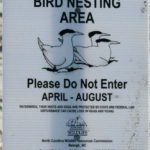
Bird Nesting Area
NC Wildlife Commission has posted signs that say – Bird Nesting Area / Please don’t disturb. The signs are posted on the west end beach strand around 1307 OBW.
People and dogs are supposed to stay out of the area from April through November
. 1) It’s a Plover nesting area
. 2) Allows migrating birds a place to land and rest without being disturbed
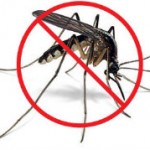
Mosquito Control
Current EPA protocol is that spraying is complaint driven
The Town is unable to just spray as they had in the past
. 1) Complaint based
. 2) Citizen request
. 3) Proactively monitor hot spots
They recommend that you get rid of any standing water on your property that you can
Urged everyone to call Town Hall if they have mosquito issues so that they can spray
Spraying is complaint based, so keep the calls coming!
 Solid Waste Pick-Up Schedule
Solid Waste Pick-Up Schedule
GFL change in service, trash pickup will be twice a week. Starting the Saturday before Memorial Day through the Saturday after Labor Day: Pick-up is every Tuesday and Saturday from May 27th through September 30th
Please note:
. • Trash carts must be at the street by 6:00 a.m. on the pickup day
. • BAG the trash before putting it in the cart
. • Carts will be rolled back to the front of the house
Solid Waste Pick-up Schedule –
starting the Saturday before Memorial Day (May 27th) twice a week
Recycling –
starting after Memorial Day (May 23rd) weekly pick-up
Curbside Recycling
GFL Environmental is now offering curbside recycling for Town properties that desire to participate in the service. The service cost is $106.88 annually paid in advance to the Town of Holden Beach and consists of a ninety-six (96) gallon cart that is emptied every other week.
Curbside Recycling Application » click here
Curbside Recycling Calendar » click here.

Trash Can Requirements – Rental Properties
GFL Environmental – trash can requirements
Ordinance 07-13, Section 50.08
Rental properties have specific number of trashcans based on number of bedrooms.
* One extra trash can per every 2 bedrooms
§ 50.08 RENTAL HOMES.
(A) Rental homes, as defined in Chapter 157, that are rented as part of the summer rental season, are subject to high numbers of guests, resulting in abnormally large volumes of trash. This type of occupancy use presents a significantly higher impact than homes not used for summer rentals. In interest of public health and sanitation and environmental concerns, all rental home shall have a minimum of one trash can per two bedrooms. Homes with an odd number of bedrooms shall round up (for examples one to two bedrooms – one trash can; three to four bedrooms – two trash cans; five – six bedrooms – three trash cans, and the like).
Building Numbers
Ocean front homes are required to have house numbers visible from the beach strand.
Please call Planning and Inspections Department at 910.842.6080 with any questions.
§157.087 BUILDING NUMBERS.
(A) The correct street number shall be clearly visible from the street on all buildings. Numbers shall be block letters, not script, and of a color clearly in contrast with that of the building and shall be a minimum of six inches in height.
(B) Beach front buildings will also have clearly visible house numbers from the strand side meeting the above criteria on size, contrast, etc. Placement shall be on vertical column supporting deck(s) or deck roof on the primary structure. For buildingswith a setback of over 300 feet from the first dune line, a vertical post shall be erected aside the walkway with house numbers affixed. In all cases the numbers must be clearly visible from the strand. Other placements may be acceptable with approval of the Building Inspector..
![]()
BOC’s Meeting
The Board of Commissioners’ next Regular Meeting is scheduled on the third Tuesday of the month, June 20th

News from Town of Holden Beach
The town sends out emails of events, news, agendas, notifications and emergency information. If you would like to be added to their mailing list, please go to their web site to complete your subscription to the Holden Beach E-Newsletter.
For more information » click here
Volunteers needed
The Town is always looking for people to volunteer for their various boards and committees. If you are interested in serving, please fill out a resume form and submit it to [email protected].
 Elevators
Elevators
Most states mandate that elevator systems be tested and inspected annually. Currently the state of North Carolina does not require annual inspections to be performed on all elevator systems. The use of unsafe and defective lifting devices imposes a substantial probability of serious and preventable injury to your family and guests. It is in the owner’s best interest to minimize injuries and liability by scheduling an annual safety inspection to ensure the safe operation of their elevator system.

Library
If you need something to keep you busy in this colder weather, make sure to visit the island library. The library is in the upstairs of Holden Beach Town Hall. All the books were donated. Patrons of the library don’t have to check out a book; they are on the honor system to return it.

Neighborhood Watch –
• Need to look out for each other
• Call 911 if you see or hear anything suspicious
• Fill out Keep Check Request Form if you will be out of town
• Pickup copy of Protecting Your Home..
Storm Events –
 Hurricane Vehicle Decals
Hurricane Vehicle Decals
Property owners will be provided with four (4) decals which will be included in their water bills. It is important that you place your decals on your vehicles immediately to avoid misplacing them. Decals will not be issued in the 24-hour period before an anticipated order of evacuation.
The decals are your passes to get back onto the island to check your property in the event an emergency would necessitate restricting access to the island. Decals must be displayed in the lower left-hand corner of the windshield, where they are not obstructed by any other items. Officials must be able to clearly read the decal from outside the vehicle. Please note that re-entry will NOT be allowed if a current, intact decal is not affixed to the windshield as designated.
EVACUATION, CURFEW & DECALS
What is a State of Emergency?
A proclamation by the Town which enacts special ordinances and/or prohibitions during emergency situations to protect the public, public health and property. These prohibitions can include limitations on movement, curfews, directing of evacuations, controlling ingress and egress to the emergency area, alcoholic beverages, and more. State of Emergencies are issued in accordance with N.C.G.S. 166A-19.22.
What is a curfew?
A curfew is an order, typically during a State of Emergency, which requires all persons in the affected areas to remain on their own property. During a curfew, you are not free to move about public domain areas or on others’ property. Violations of a curfew could lead to arrest in certain situations.
What is a voluntary evacuation?
A voluntary evacuation creates a recommendation for all parties in the affected area to get their affairs in order hastily and evacuated.
What is a mandatory evacuation?
A mandatory evacuation means you must leave the area in which an order has been issued. With recent changes to the laws in North Carolina, you no longer have the option of staying in an area under an order of mandatory evacuation.
Why is the sewer system turned off during a storm/event?
Often the sewer system is turned off during storms which have the potential to create significant flooding on the island. The system is turned off to protect its integrity. If it were left on, it could pose a significant threat to the public health. When the system is manually shut down, it also greatly reduces the time needed to bring it back up after an event which equates to getting residents and guests back on the Island much faster.
Why is there a delay for decal holders to get back on the island once a storm ends?
After a storm, many things must occur before even limited access can be allowed. Some of those things include making sure the streets are passable; the sewer system must be restarted to comply with State laws; the utilities (water, sewer, electricity, propane supplies) must be checked to ensure no safety risk are present; and the post-storm damage assessment team needs to perform an initial assessment.
Where can I get up-to-date information during and after a storm or State of Emergency?
You can sign up for the Town email service by clicking here. The newsletter, along with the Town’s website will be the main sources of information during an emergency situation. Links to the Town’s official Facebook and Twitter pages can be found on the website. You can also download our app for Apple and Android phones by accessing the app store on your smart phone and searching Holden Beach.
Please refrain from calling Town Hall and Police Department phone lines with general information questions. These lines need to remain open for emergencies, storm management and post-storm mitigation. All updates concerning re-entry, general access, etc. may be found on the Town’s website and other media outlets.
Why do I see others moving about the island during a curfew?
If a curfew order is in place, you must stay on your own property. You may see many other vehicles moving about the Island. We often receive assistance from other local, state, federal and contract personnel during events. It is likely these are the personnel you are seeing, and they are involved in the mitigation process for the event. Please do not assume that a curfew order has been lifted and/or you are free to move about the island.
Can I check my friends’ property for them?
If a curfew order is in place, you may ONLY travel to your personally owned property. Traveling about the Island to check on others’ property is not allowed. is in place, you may ONLY travel to your personally owned property. Traveling about
Who can obtain decals?
Only property owners and businesses who service the island can obtain a decal.
How do I get decals for my vehicle…?
If I am an owner?
Decals will be mailed out in water bills to property owners before the season starts. Those owners who need additional decals can contact Town Hall. A fee may apply, please check the current fee schedule.
If I am a renter?
You must contact the owner of the property to obtain a decal.
If I am a business owner on the Island?
You must contact Town Hall to obtain a decal.
If I am a business owner off the Island that provides services on the Island?
You must contact Town Hall for eligibility and to obtain a decal.
When does my decal expire?
All decals expire on the last day of the calendar year as indicated on the decal.
Where do I put my decal on my car?
Decals must be displayed in the lower left-hand corner of the windshield, where they are not obstructed by any other items to include window tinting, other decals, etc. Officials must be able to clearly read the decal from outside the vehicle. Please note that re-entry will not be allowed if a current, intact decal is not affixed to the windshield as designated.
How do I replace a decal if I get a new vehicle?
If you trade a vehicle or otherwise need a replacement decal, you may obtain them from Town Hall during normal business hours. A fee may apply, check the current fee schedule.
Can I obtain a decal right before an emergency occurs?
While most of the storms we deal with are tropical in nature with some type of advanced warning, we do experience many other types of events that could create a State of Emergency without warning. All eligible parties should obtain decals as early as possible each year to avoid being denied access to the Island. Decals shall not be issued during the 24-hour period prior to an anticipated order of evacuation so staff can concentrate on properly preparing the Town for the storm/event.
Can I use a tax bill or another document for re-entry?
No. You MUST have a decal to re-enter the Island until it is open to the general public.
How does re-entry after a storm during a State of Emergency work?
The bridge is closed to all vehicle access, except for official vehicles. Once those with proper decals are allowed access, they must conform with the current rules in place by the specific State of Emergency Order. After all hazards have been rendered safe, the bridge will be opened to the general public. A curfew could remain in effect however, to ensure the safety and security of the Island and its residents and guests. Please understand this process typically takes days to evolve and could be significantly longer, depending on the amount of damage sustained. Please refrain from calling for times for re-entry, as those are often not set on schedule. Instead, stay tunes to local media outlets and official social media accounts for accurate updates.
How can I check on my property if access is limited to the Island?
Once it is safe, property owners with valid decals will be allowed back on the Island after a storm/event. At this point, you can travel to your property, in accordance with the rules of the specific State of Emergency Order currently in place.
If you live out of the area, please do not travel to the Island until you are certain you will be allowed access. Stay tuned to those media outlets and email services that are of official nature for this information. Also, be certain you have your current, valid decal properly affixed to your vehicle.
It is a good idea to be sure your contact information is current with the Town tax office as this is the location Town officials will use in the event you need to be contacted.
For more information » click here
NC General Statute 166A-19.22
Power of municipalities and counties to enact ordinances to deal with states of emergency.
Synopsis – The governing body may impose by declaration or enacted ordinance, prohibitions, and restrictions during a state of emergency. This includes the prohibition and restriction of movements of people in public places, including imposing a curfew; directing or compelling the voluntary or mandatory evacuation of all or part of the population, controlling ingress and egress of an emergency area, and providing for the closure of streets, roads, highways, bridges, public vehicular areas. All prohibitions and restrictions imposed by declaration or ordinance shall take effect immediately upon publication of the declaration unless the declaration sets a later time. The prohibitions and restrictions shall expire when they are terminated by the official or entity that imposed them, or when the state of emergency terminates.
Violation – Any person who violates any provisions of an ordinance or a declaration enacted or declared pursuant to this section shall be guilty of a Class 2 misdemeanor.
Turtle Watch Program –
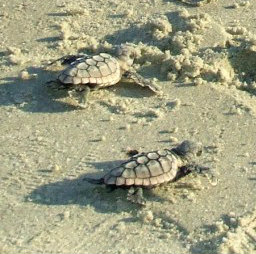
Turtle Watch Program – 2023
• The first nest of the 2023season was on 05/12/23 • Average annual number of nests is 57
Members of the patrol started riding the beach every morning on May 1 and will do so through October looking for signs of turtle nests.
For more information » click here.
Anxiously awaiting
The turtle nesting season started on May 1 here in Holden Beach. Our riders began early morning searches for signs of mother turtles laying eggs on our beach. The earliest date we’ve recorded of a nest on Holden Beach was on May 8, 2021—when we were the first nest in North Carolina. Last year the first nest was on May 21. May 20 has been a frequent first nest date! This was the first nest in 2014, 2015 and 2018. Since it is turtle season, we’d like to remind everyone to turn off ocean facing lights in beach front property. Please do not use flashlights on the beach and fill in holes dug in the sand before you leave the beach.
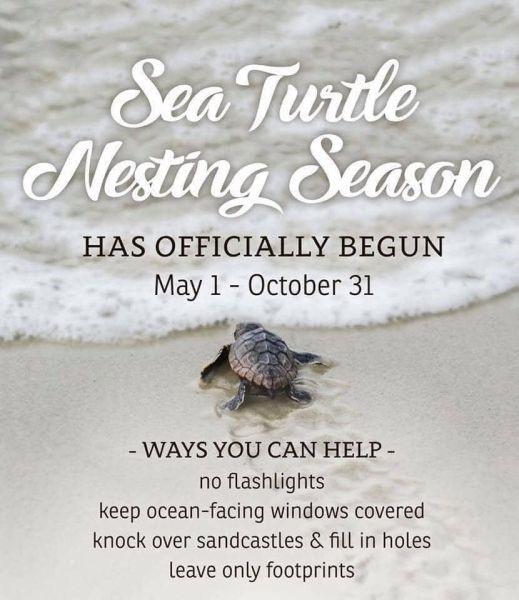
From boats to beaches,
challenges facing sea turtles as nesting season starts in NC
As temperatures rise as summer approaches so do the number of sea turtles in North Carolina’s coastal waters. But also increasing is the number of boats in those very same waters, and for the sea turtles that often can be a dangerous proposition. For staff at the Karen Beasley Sea Turtle Rescue and Rehabilitation Center in Surf City, the warming weather means they’ll be seeing more patients with damaged shells and flippers as concerns over rehabilitating cold-stunned turtles during the winter pivots to trying to save those struck by boat propellers. Sometimes it can be a sobering experience. The Brunswick County Sheriff Office’s Marine Patrol in mid-April rescued a Kemp’s Ridley sea turtle in the Intracoastal Waterway near Sunset Beach that appeared to have been struck by a boat propeller. The turtle eventually made its way to the sea turtle hospital for treatment. But staff found the turtle, dubbed “Hope Sapphire,” to be suffering from too many injuries to be rehabilitated. Terry Meyer, the hospital’s deputy director and conservation director, said not being able to save every turtle that comes through the hospital’s doors can be tough. But, pointing to a pair of small tubs containing two of the hospital’s newest residents, juvenile green sea turtles that had sustained damage from boat propellers, she said it’s satisfying knowing that many more turtles have a fighting chance because of the work done at the Pender County facility. That’s not just through treating injured animals or giving curious visitors a tour of the facility. Hospital staff and volunteers work with local turtle protection groups, which walk area beaches to look for nests, and hold releases up and down the coast to raise awareness and interest in the sea turtles. “It’s helping get that awareness out there,” said Meyer, who has been with the hospital for 27 years, last week. “They are such a charismatic animal, so people like to see them, experience them. But we need to have limits.”
Nesting challenges
That’s especially true when it comes to beach nesting season, which started in North Carolina May 1. “Our No. 1 greatest threat is artificial lighting,” Meyer said. “It’s our biggest concern because the lights can not only disorientate the nesting female as she comes ashore, but also the hatchlings because they’re going to move toward the brightest light they see when they come out of their nest, and we want that to be the moon or the stars as they make their way toward the ocean.” Predators like foxes and raccoons along with overanxious tourists eager to see and get selfies with a giant marine reptile that predates the dinosaurs are other challenges nesting sea turtles and their hatchlings can face. With the nearly weekly turnover in beach visitors during the summer, Meyer said it’s a constant challenge to educate people on proper sea turtle etiquette. “It takes a long time to get a 2-ounce hatchling big enough to come back and nest,” she said, noting that around 30 years is the average time a female loggerhead − North Carolina’s most common sea turtle − has to mature before she’ll return to the area of her birth beach to lay her own eggs. “And that adult might be the only one who survives from 10 or 20 nests that were laid that season.”
Climate change impacts?
While boats and beachgoers might be some of the most obvious challenges sea turtles face, they are by no means the only ones. Climate change is one scientists worry that could impact the marine reptiles in several ways. On the beach, the warming weather is increasing sand temperatures, which helps determine the sex of hatchlings as the buried eggs incubate. If the beach is warmer than 89 degrees, most of the hatchlings will be female; if it’s cooler more will be male. For a long time, researchers have believed that the cooler beaches in the Carolinas produced males to mate with the female-heavy hatchlings produced by the warmer beaches in Florida and along the Gulf Coast. But what will happen if all the country’s beaches get so warm that the vast majority of hatchlings are female? A warming climate, which scientists are predicting for North Carolina in the coming years, also could impact when sea turtles nest. Sea turtle nesting season in the Tar Heel State generally runs from May through August. Dr. Matthew Godfrey, a sea turtle biologist with the N.C. Wildlife Resources Commission, said data so far hasn’t shown turtles nesting earlier in North Carolina. “But anecdotally we have observed a few turtles nesting in September and even October,” he said via email. Ocean Isle Beach saw its first nest on Monday. It is the second earliest verified nest in the Brunswick County town’s history, according to the Ocean Isle Beach Sea Turtle Protection Organization. The only one to beat it was a nest laid May 6, 1995. Forty-five miles up the coast, the Masonboro Island Reserve between Wrightsville Beach and Carolina Beach also was celebrating a nest laid Friday, laying claim to the first North Carolina nest of the 2023 season. Climate change is also forecast to mean more powerful and bigger tropical weather systems, like hurricanes, that can impact coastal areas and beaches where sea turtles nest and forage.
Long-term conservation effort
Even with the growing list of challenges facing sea turtles, including intense development along some of their nesting beaches, it’s not all murky waters for the animals that can live to be 100. Godfrey said that while nest numbers vary by years, there generally has been an upward trend in nesting numbers in the Southeast. “We hope increases in the number of loggerhead nests laid in N.C. (and S.C. and Georgia) are the result of conservation measures put into place in the 1980s and 1990s,” he said, noting that more than 95% of nests in North Carolina are loggerheads. “We hope the trend continues.” Last year the wildlife commission recorded 1,958 sea turtle nests in North Carolina, producing an estimated 209,405 eggs. That’s up from 1,296 nests in 2015 and 881 in 2010. Back at the hospital in Surf City, Meyer echoed Godfrey’s message. “This is a long-term conservation effort, but that’s OK,” she said. “We’ll learn in 50 years how successful we’ve been.”
Read more » click here
Upon Further Review –
In the continuing saga of Mark Saunders and the Coastal Companies …

With several Brunswick abandoned developments, landowners playing long waiting game
In 2010, John McClellan purchased a lot in the Brisa del Mar section of Seawatch at Sunset Harbor. At the time, McClellan was 63 years old and imagined spending his days relaxing, enjoying life by the water. An engineer by trade, he knew exactly what he wanted in his home. Many who purchase lots on the water want to build mansions, but McClellan wanted something smaller, about 2,500-3,000 square feet, because it was just him and his wife. “I’ve already got the design and money in the bank,” he explained. “I don’t need financing; I can just go do it.” But to build his home, he needs infrastructure. And 13 years later, it’s still lacking. McClellan is not alone. He is just one of the many people who purchased lots in developments around Brunswick County that were never completed after the housing market crash of 2007. The years following the housing market crash were difficult for local builders, developers, and real estate brokers. But in the last few years, the housing market across the region has rebounded and appears to be experiencing another boom. With home prices and interest rates both rising, some worry history could repeat itself. However, economists say it’s not likely, and county officials say they’ve taken steps to prevent Brunswick from becoming a land of zombie villages.
A look at the numbers
Brunswick County’s coastline has always drawn in tourists. But around the late 1990s and early 2000s, developers really began to capitalize on the area’s potential. The coast provided the perfect backdrop for a year-round paradise, and with 850 square miles of land area, much of which was then vacant land, developers began to create planned communities, offering golf courses, marinas, community centers, and pools to attract retirees. By the mid-2000s, homes were listed and sold in a day, and new communities were being added to rapidly increase the available housing stock. According to data obtained from Brunswick County, there were more than 33,000 housing units approved from January 2005 to December 2007. After the housing market crash, that number dropped dramatically. From January 2008 to November 2011, county records show only about 4,700 housing units were approved with that number dropping to zero from 2012 to June 2015. Then the market picked up slowly with just over 12,000 housing units approved from June 2015 through December 2019, and then from January 2020 through March 2023, the area began experiencing another development boom. According to Brunswick County spokeswoman Meagan Kascsak, since March 2020, the county has approved approximately 27,000 housing units across 81 different developments. This doesn’t include developments located inside Brunswick County’s municipalities. In addition to the number of new developments proposed, housing and land prices have been climbing. Many residents saw significant increases in their property values when Brunswick County released its revaluations earlier this year.
Changes in economy, policies may prevent future crash
With new housing developments popping up across the county and prices and interest rates both climbing, some fear there could be another crash. But economists say today’s market is very different from that of the early 2000s. Dr. Mouhcine Guettabi, associate professor of economics at the University of North Carolina Wilmington and regional economist, said borrowers today have higher credit scores and are better off financially than in 2007-2008. He also noted in 2007, there were more sub-prime borrowers and lending standards “were much looser,” with many borrowers having little to no down payments on their homes. “This meant that there was very little cushion to protect them from housing price decline,” he explained in an email. However, Guettabi noted the most important factor in the 2007 crash was the significant increase in the housing supply in the preceding years. “This time around, we did not have the same level of excess which has kept supply fairly constrained,” he said. He said other factors to consider are that most households now are locked in to mortgages with 2 to 3 percent fixed rates resulting in lower monthly payments, and the majority of people are now living in properties worth considerably more than the purchase price. “This means housing prices would need to drop by a considerable amount for people to find themselves upside down,” he said. Guettabi said while a housing market crash like the one the country experienced in 2007 is unlikely, the demographics of Brunswick County are different from neighboring New Hanover and Pender counties, and therefore the impact in each of the three areas would be different. “All three counties saw considerable in-migration, which has fueled the increase in prices,” he said. “Given that Brunswick County has attracted an older population that is typically financially healthier, they could be more sheltered from any downside especially (since) a larger share of these individuals bought their properties in cash.” In addition to a different market, county officials have learned from the 2007 crash and instituted policy changes to prevent situations like the one McClellan experienced. “The option for developers to bond infrastructure improvements was nearly entirely eliminated in Brunswick County back in 2015,” Kascsak said in an email. “Since then, the developers must install all required infrastructure before recording lots or obtaining building permits.”
What’s happening with the current zombie developments?
While a repeat of 2007 seems unlikely, many are still dealing with the fallout of the previous crash. Lot owners across the county are still waiting for infrastructure to be installed in order to build their homes. Kascsak said many of the zombie developments located in the county’s jurisdiction have been purchased by other companies and are being redeveloped. “In some others, the county has collected on the bonds or financial guarantees that were secured at that time and installed the infrastructure,” she said. But that’s not the case for developments located in the county’s municipalities. In those instances, it’s up to the municipality to call the bond, and though it’s been 15 years since the crash, some have yet to do that. That’s the case for many lot owners in Seawatch at Sunset Harbor. Dr. Timothy Boehm, an endocrinologist living in Arkansas, purchased two adjacent lots on the Intracoastal Waterway in the Brisa del Mar section of Sea Watch, which is located in Oak Island’s extra-territorial jurisdiction. He made his purchase in 2011 after the crash when prices had dropped significantly. While Boehm knew nothing was built at the time, he was promised infrastructure was in the works and would soon be in place. Like McClellan, Boehm planned to build a home and retire there. He explained he graduated from Duke University’s medical school, and his wife graduated from Salem Academy, so both have connections in North Carolina and looked forward to calling Brunswick County home. But with no infrastructure, Boehm hasn’t been able to make that dream a reality. He, McClellan and others are still waiting for Oak Island to call the infrastructure bond. Mike Emory, spokesman for the Town of Oak Island, said the most recent action on Seawatch occurred during the February 9, 2021 town council meeting. In an email, Emory said following a public hearing, the council unanimously voted to deny a request for a three-year extension for the permit for the Seawatch Marina and phase 15 major subdivision plans. Emory said he wasn’t aware of any actions taken since or if any were planned for the future. The StarNews reached out to a representative for Coastal Communities, an affiliate company The Coastal Companies, developer of Seawatch at Sunset Harbor and Ocean Ridge Plantation, to find out more about plans to install infrastructure in these communities. The individual declined to comment saying that information would be provided only to property owners. Both McClellan and Boehm say they’ve received offers from companies asking to purchase their lots for prices ranging from $5,000 and $10,000, but neither are planning to sell. Boehm, now in his 70s, plans to remain in Arkansas. “It’s pretty comfortable,” he said. “Little Rock is not the end of the world. It would have been nice to live there, but we don’t have to either.” McClellan now lives in Sunset Beach part-time. He purchased a condo in Sunset Beach to be closer to Sea Watch while his home was being built. Though he spends his summers in Alaska, McClellan still holds out hope Oak Island will call the bond and infrastructure will be installed. He believes building out the community as intended would be good for the area because it would significantly increase the tax base and bring in people like him — retired seniors who are well-off financially — to stimulate the area’s economy in the winter months. “It’s a win-win for everybody,” he said. But he adds if he hopes to enjoy it, it has to happen soon. He’s now 76 years old. “It’s getting a little late in life for me to enjoy that lifestyle,” he said. “But if it happens in the next year, I will give it a try.”
Read more » click here

The ‘Cadillac’ of Brunswick:
After promises of grand homes, owners left with huge losses
In 2007, Gary Gaglione was working toward his goal of retiring on North Carolina’s coast. He thought he had found the perfect place to call home: Ocean Ridge Plantation. At the time, the development had several successful neighborhoods and a fifth called Jaguar’s Lair was in the works. “It was supposed to be the Cadillac of the development,” Gaglione explained. “Basically, the best one yet.” At the time, Brunswick County was experiencing a real estate boom, and lots in Jaguar’s Lair were selling for more than $250,000. Believing it a good investment, Gaglione purchased a lot. He looked forward to building his retirement home. More than 15 years later, Jaguar’s Lair is a far cry from the promised land pictured in the marketing materials. Orange pipes protrude from the ground waiting for homes that were never built, and dirt paths exist where roads were supposed to be. Lots bought there for more than $200,000 in 2007 are now regularly appraised at less than $20,000. A recent update suggests some improvements, but lot owners believe it’s long overdue. They say a combination of bad business practices, the housing market collapse, years of inaction, and no relief from increasing homeowners’ association fees have shattered the dreams they once had and left them trying to recoup a fraction of the money they invested.
Big promises, big prices
In 2008, Donald Dunn was looking for an investment property. He wanted it to be a place he might call home one day. He found Ocean Ridge, and there he learned about Jaguar’s Lair. Marketed by Coastal Communities, a division of The Coastal Companies founded by developer and builder Mark A. Saunders, Jaguar’s Lair would be the newest phase of Ocean Ridge. “It was going to be unique,” Dunn explained. “It was going to be part of Ocean Ridge, but its own separate development with its own golf course not accessible to Ocean Ridge members, only those living in Jaguar’s Lair.” Dunn perused the lots and found one he liked. He recalled it being a high-pressure environment. “We were under the impression that lots were selling, and we wouldn’t get the lot we wanted if we didn’t buy immediately,” Dunn said. “So, we bought the lot and paid through the nose like everybody else.” Though he can’t recall the exact amount he paid, he remembers it was close to $300,000. Gaglione also fell in love with the Jaguar’s Lair section of Ocean Ridge. It offered golf, amenities, and nearby Sunset Beach. At the time, there were even plans to build a water park near the development. “My dream was to build and retire down here and have a legacy for my kids and grandkids,” he explained. Gaglione paid for a lot platted for the tenth fairway of the Jaguar’s Lair golf course.
Market crash, progress stops
Dunn recalled soon after he purchased his lot, the housing market crashed, and at that point, work on Jaguar’s Lair seemed to stop. Lot owners, like Dunn, Gaglione and many others, were unable to build homes due to a lack of infrastructure. This led to a years-long battle between Coastal Communities and Sunset Beach. The StarNews reached out to The Coastal Companies and Ocean Ridge, but officials declined to comment. According to a news release dated Jan. 13, 2015, the dispute began in 2014 when the town refused to release the bond for section one of Jaguar’s Lair due to what it claimed was incomplete infrastructure. In the release, the town also alleged Coastal Communities declined to meet “despite repeated requests to continue bargaining.” With mediation reaching an impasse, the town called the bond, resulting in a court battle that would not end until August 2017. According to an agreement, the developer would complete infrastructure work in sections one and two of Jaguar’s Lair.
Infrastructure years in the making
In 2018, Sunset Beach began receiving progress reports from Coastal Communities about Jaguar’s Lair. The most recent one, dated Feb. 2, 2023, stated the sewer system had passed all testing, installation of water services to all lots had been completed, and the contractor was “performing clean-up work, such as grading disturbed areas and preparing for a walk through with Brunswick County.” The letter also stated electric conduit had been installed at road crossings, survey work for road construction was under way, and a contractor was scheduled to demolish and remove the remnants of the old clubhouse structure, which was deemed “an unsafe building that is dangerous to human life” more than four years earlier. While the demolition and removal were scheduled to be completed by January 31, the letter stated, “the contractor requested an extension — as has been the norm over the past few years.” At press time, Sunset Beach Town Administrator Lisa Anglin said the town had not received any progress updates since February. Anglin said work in Jaguar’s Lair is progressing. “Section 1 is complete and property owners can build homes now,” Anglin said in an email. “Once section 2 is completed, property owners will be able to build.” Anglin did not indicate a timeline for the completion of infrastructure in section two but did say the property lies in Sunset Beach’s extraterritorial jurisdiction. Those wishing to build homes will work with the town’s building inspections department for permitting. When asked if the developer Mark Saunders and the Coastal Companies was committed to finishing the development in Jaguar’s Lair, Anglin said it is the town’s “understanding that the developer will complete installation of the required infrastructure.” “We are not aware of what company will construct homes,” she said.
Plummeting values, increasing fees
For years, those owning lots in Jaguar’s Lair have watched and waited, hoping one day their investments will pay off. Gaglione attempted to rally a group of Jaguar’s Lair lot owners to file a class action suit. But he noted after hearing previous lawsuits were unsuccessful and learning it could cost around $50,000 with no promise of a victory, no one was interested in joining him. Meanwhile, Gaglione and Dunn have seen their lot values plummet. According to Brunswick County tax records, Gaglione’s lot, which is assigned an address of 7535 Wallace Place SW, lists a 2007 sales price of $326,000 and indicates a current appraised value of $12,300. Dunn said he saw his lot value decrease to around $5,000. Both men claim while their lots remained unbuildable, they had to continue paying the full amount of HOA dues. “We got stuck supporting the lifestyle of the Ocean Ridge folks even though we couldn’t do anything about our own situation,” Dunn said. After being notified of his annual HOA assessment of $1,872, Gaglione sent a letter to the Ocean Ridge Homeowner’s Association arguing the Jaguar’s Lair lot owners should be exempt from HOA fees because according to the development’s covenants, “any lot which is not approved by a governmental agency for residential use” is exempt from “Base Assessments, Village Assessments, and Special Assessments.” In the letter, Gaglione stated since purchasing his lot in 2007, he has paid a total of $12,956 in HOA fees, despite not being able to build a home. He added he would not pay the 2022 fees. Also tired of paying increasing HOA fees, Dunn contacted the Ocean Ridge sales office about putting his lot on the market and “got a bite” the following day. “Last week, we bit the bullet and sold our lot,” he said. Dunn said it went for $20,000 to a couple from New York, and while it sold for about 10 percent of the original sales price, he said he’s fortunate to have received that much. For both men, any dream of one day settling in Ocean Ridge has been shattered. Originally from Delaware, Dunn now lives in Charlotte and has purchased a home on the beaches of Delaware where he hopes to spend part of his retirement. Gaglione still owns his lot with the hope of selling it for more than its current tax value. “I’m not asking anyone to make up for my initial stupidity,” he said, with a chuckle. “I’m just hoping to get $30,000 or $35,000 for it when the infrastructure is done.” Gaglione still lives in New Jersey and has no plans to build in Ocean Ridge. But he hasn’t completely written off moving to Brunswick County. “I’d seriously consider St. James or another community in that area,” he said.
Read more » click here
Progress report:
5 things you need to know about what’s happening in Jaguar’s Lair
While many property owners in the Jaguar’s Lair section of Ocean Ridge Plantation remain unable to build homes on the lots they purchased more than a decade ago, slow progress is being made in the village. In accordance with a subdivision improvements agreement — dated Aug. 22, 2017 — between the town of Sunset Beach and Coastal Communities at Ocean Ridge Plantation, LLC — the developer of Jaguar’s Lair — regular progress updates must be provided to the town. The most recent update was provided on May 2.
Here are five things to know about the project’s status.
Town representatives visited the site in March.
According to a letter from Becky Noble, vice president of Coastal Communities at Ocean Ridge Plantation, Sunset Beach town representatives wanted to see progress on the removal of the old Angels Trace Clubhouse, which town documents show was deemed “an unsafe building that is dangerous to human life” several years earlier. In her letter, Nobles stated the removal of the clubhouse was “not related to the subdivision improvements agreement,” but since the town representatives visit, the “clubhouse structure and all its components, including the asphalt driveway approaches” has been removed. “The site is clean and has been graded to match the surrounding grade as closely as possible,” the letter stated.
Most underground infrastructure has been installed.
According to the letter, the stormwater, sewer, and water systems have all been installed, and the engineer has completed “as-built drawings” for the water and sewer. “Those systems will be dedicated to the County once the roads are paved,” Nobles wrote.
Road work is beginning.
The letter stated, “roads have been graded to allow for the commencement of concrete curbing work,” which involves coordination between two contractors and “requires substantial precision.” The document explained the process, which involves stringing lines, pouring concrete for much of the curb with some sections located near grates being poured and hand-finished, and it noted frequent rain would disrupt the process, forcing it to be repeated or postponed.
Additional work is underway.
In the letter, Nobles wrote that crews “should be able to start back-fill work and seeding behind the curb soon on those areas poured first,” and they would continue to do this as sections finish curing. She noted other support work, including surveying and monitoring grades is “occurring continuously,” and this month, crews hope to begin installing the stone base on roads where curbing is completed. “The project is now taking on a much different look, as the infrastructure now being installed is all above ground and roadways are better defined by curbing,” the letter stated.
No date has been given for completion of the work.
The update provided this month to the Sunset Beach town officials indicated the Coastal Communities would continue to provide progress updates, but it did not include an estimated completion date. “The Town does not have a timeframe of when the infrastructure installation within Jaguar’s Lair will be completed; however, the Town is encouraged by the progress that has been made in recent months to complete the installation,” Sunset Beach Town Administrator Lisa Anglin said in an email. The StarNews reached out to Nobles for comment but attempts to contact her were unsuccessful. Gary Gaglione owns a lot in Jaguar’s Lair and just visited the property on May 9. “They are making progress, but in my estimation, it’s very slow,” he said. Gaglione’s lot currently remains unbuildable, and he said he has not been given an estimated completion date for the infrastructure work. Earlier this month, Gaglione filed a claim in Brunswick County small claims court seeking to have his HOA dues refunded for the years he has paid on a lot that is deemed unbuildable. His court date is set for June 7.
Read more » click here
Corrections & Amplifications –
Paid Parking on Holden Beach
Paid parking will be enforced April 1st – October 31st in all Holden Beach designated parking areas. It will be enforced from 9:00 a.m. – 5:00 p.m. daily, with free parking before and after that time. All parking will use license plates for verification.
As a reminder, Holden Beach uses the “SurfCAST by Otto” parking solution. Annual passes are now available for purchase on the mobile app. You will also be able to purchase passes by scanning the QR-codes located on the parking signs for access to https://surfcast.ottoconnect.us/pay.
Rates for the 2023 season are as follows:
$4 per hour for up to four hours
$20 per day and for any duration greater than four hours
$80 per week (seven consecutive days)
Annual Passes:
$150 per calendar year for a single vehicle
$300 per calendar year for two vehicles
Handicap parking is free in designated handicap spaces and only with a valid license plate or hangtag.
Parking rates can be paid via credit card, debit card or PayPal.
Visit https://hbtownhall.com/paid-parking for more information and to view a table with authorized parking areas.
Odds & Ends –

North Carolina records highest-ever tourism spending year
Governor Roy Cooper announced Tuesday the North Carolina tourism economy reached its highest level ever in 2022, with travelers spending more than $33.3 billion on trips to and within the state. The previous record of $29.22 billion was set in pre-pandemic 2019. “Tourism is a vital economic force in our state supporting thousands of small businesses and hundreds of thousands of jobs,” Governor Cooper said. “We can take pride that visitors see North Carolina as a diverse, inclusive and welcoming place and we all need to work to keep it that way.” Governor Cooper’s announcement coincides with National Travel and Tourism Week, when travel and tourism professionals across the country unite to underscore the value of travel to the economy, businesses, communities and personal well-being. The state’s tourism-supported workforce increased 9.8 percent to 216,900 jobs in 2022, according to a press release. That figure reverses the more than 26 percent loss in employment suffered in 2020. Tourism payroll increased 13.5 percent to $8.7 billion.
Read more » click here
North Carolina tourism spending hits new record of $33.3 billion
North Carolina has set a new record for the amount of money brought into the state from tourism. Tourism officials said last year $33.3 billion was spent by people visiting the state. The announcement coincides with this week, May 7-13, being National Travel and Tourism Week. This figure includes money spent by locals and visitors. The highest before had been $29.22 billion in 2019. Tourism suffered a 26% employment and travel loss in 2020, but this has been reversed with a boom in travel across the state, according to tourism leaders. “Tourism is a vital economic force in our state supporting thousands of small businesses and hundreds of thousands of jobs,” Governor Roy Cooper said. “We can take pride that visitors see North Carolina as a diverse, inclusive and welcoming place and we all need to work to keep it that way.”
The Department of Commerce provided the following tourism facts:
- Total spending by domestic and international visitors in North Carolina reached $33.3 billion in 2022. That sum represents a 15.2 percent increase over 2021 expenditures. The figure falls 14 percent above the record $29.22 billion spent in 2019.
- Domestic travelers spent a record $32.4 billion in 2022. Spending was up 13.4 percent from $28.6 billion in 2021.
- International travelers spent $910 million in 2022, up 170 percent from the previous year.
- Visitors to North Carolina generated $4.2 billion in federal, state and local taxes in 2022. The total represents a 7.9 percent increase from 2020.
- State tax receipts from visitor spending rose 6.5 percent to nearly $1.3 billion in 2022.
- Local tax receipts grew 3.5 percent to nearly $1.2 billion.
- Direct tourism employment in North Carolina increased by 9.8 percent to 216,900.
- Direct tourism payroll increased 13.5 percent to $8.7 billion.
- Visitors spend more than $91 million per day in North Carolina. That spending adds $6.7 million per day to state and local tax revenues (about $3.5 million in state taxes and $3.2 million in local taxes).
- Each North Carolina household saved $512 on average in state and local taxes as a direct result of visitor spending in the state. Savings per capita averaged $230.
- North Carolina hosted approximately 43 million visitors in 2022.
Read more » click here
This and That –
What rising sea levels mean for where and how we live along the NC coast
With several recent academic studies warning of increased sea-level rise along the North Carolina coast and the June 1 start of hurricane season just around the corner, the old question of whether we can continue with development along the oceanfront as normal − or at least as we have been building − is garnering new attention. For decades, state regulators have used historical erosion rates to determine how far back from the first stable line of natural vegetation, often referred to as the dune line, a structure can be built. These setbacks are based on average long-term erosion rates that reflect changes in North Carolina’s shoreline over nearly half a century. The rules are more stringent in areas near inlets that are notoriously unstable and can quickly erode as inlet channels move. While some areas of the state’s 300-mile shoreline are quite stable, especially those that receive regular beach nourishment projects, others are rapidly dwindling. Officials with the Cape Hatteras National Seashore have recorded erosion rates around Rodanthe, a small village near the northern tip of Hatteras Island, of more than 13 feet annually in recent years. Pictures of oceanfront homes in Rodanthe, four in the past 15 months, washing away into the encroaching Atlantic have made national and international news and refocused attention on the dire erosion situation along some parts of the Outer Banks.
What did the new studies say?
The studies found sea-level rise along the North Carolina coast is occurring faster than expected, and at a higher pace than most other areas of the United States. Researchers from Tulane University, in a study published in late March, found sea-level rise of about 0.5 inches a year since 2010 off the Southeast and Gulf coasts, which is three times the global average. While that might not sound like a lot, the U.S. Environmental Protection Agency says average sea level has risen by 0.14 inches since the early 1990s. An annual look by the Virginia Institute of Marine Science at William & Mary at 32 tide gauges along the U.S. coast, also released in March, showed seas continuing to rise, with areas of the Mid-Atlantic coast showing the highest increases. The study projected that by 2050 Wilmington could see an increase of up to 2.26 feet in its high tides compared to 1992 levels.
So, can we ‘retreat’ from the coast?
Yes. But there are plenty of reasons why that’s not the favored option, or even practical, in many cases. In many beach towns moving a threatened oceanfront home to another lot isn’t feasible because everything has already been developed. Many oceanfront homes, especially those built with renting out as their primary purpose, also are too big to be moved. Then there’s the financial considerations. Prices generally increase the closer you are to the ocean, meaning removing or demolishing a beachfront property can cost the homeowner and coastal towns and counties a lot of lost rental and tax revenue, not to mention the potential public relations hit. That’s led to increased interest in taking steps to stabilize beach areas seeing increased erosion, whether through hardened structures like sandbags and terminal groins to beach nourishment projects. New homes also are being built to higher standards, and simply higher on stilts, to better weather the rising seas and expected increase in strength of future tropical weather systems due to climate change. But Dr. Robert Young, director of the Program for the Study of Developed Shorelines at Western Carolina University, said rebuilding back the same way after a storm strike or just severe erosion doesn’t make economic or practical sense knowing what we know about likely future impacts along the oceanfront. “The root of the problem is we still spend tens of millions of dollars-plus on storm rebuilding and resilience, but we don’t ask those communities to do anything differently,” he said, referring to post-storm rebuilding efforts in many coastal areas. “We have those opportunities, but we just don’t take them.”
Towns that get beach nourishments are stable, right?
Like many things, a hurricane strike can change things quickly. But yes, towns that see periodic injections of fresh sand historically have more stable oceanfront areas than those that don’t. Beach nourishment, though, is expensive. And it has to be done every few years to really work. While many beach towns, notably on the Outer Banks, have recently seen new sand, it isn’t known when the next one might come since local communities generally have to foot the bill − sometimes with the state’s help − if it’s not a federal project. And beach nourishment projects aren’t cheap. Dare County officials told Rodanthe residents in January that the county couldn’t afford a nourishment project in the unincorporated village, especially after helping fund projects in several other Outer Banks communities. North Topsail Beach also has abandoned plans to participate in a beach nourishment project with Surf City due to cost concerns. Even if a town is part of a federal beach nourishment project, things don’t always go according to plan. Wrightsville Beach, which has had an Army Corps of Engineers’ beach project since the 1960s, has been waiting more than two years for fresh sand over disputes about where the new beach material should be dredged.
Are people paying a premium to live at the coast?
In short, yes. The consensus, however, is it’s not because of the risk of sea-level rise and other factors tied to climate change, like higher insurance rates, but because there simply isn’t enough oceanfront property for everyone who wants to live there. Using data from the real estate website Zillow, the online data website Stacker determined that Wrightsville Beach was the North Carolina community with the fastest growing home prices. The site said home values in the popular New Hanover County beach town averaged nearly $1.35 million in March 2023, with prices up 8.6% over one year and 82% over five years. Within the list’s Top Ten, Topsail Beach came in at No. 3, Bald Head Island No. 4, Holden Beach seventh, St, James eighth, and North Topsail Beach ninth.
Read more » click here
Factoid That May Interest Only Me –

Whatever the Problem, It’s Probably Solved by Walking
Walking is the worst-kept secret I know. Its rewards hide under every step. Perhaps because we take walking so much for granted, many of us often ignore its ample gifts. In truth, I doubt I would walk often or very far if its sole benefit was physical, despite the abundant proof of its value in that regard. There’s something else at play in walking that interests me more. And with the arrival of spring, attention must be paid. I discovered the power of ambling more than a quarter century ago when I traipsed 500 miles across Spain on the Camino de Santiago, an ancient pilgrimage route. I stumbled upon the Camino by accident and then trudged across Spain with purpose. I’ve been a walker ever since. And I’m not the only one. Hippocrates proclaimed that “walking is man’s best medicine.” The good doctor also knew that walking provided more than mere physical benefits when he suggested: “If you are in a bad mood, go for a walk. If you are still in a bad mood, go for another walk.” He was alluding to what so many who came after would attest, that walking not only nourishes the body but also soothes the mind while it burns off tension and makes our troubles recede into a more manageable perspective. Soren Kierkegaard agreed when he confessed, “I know of no thought so burdensome that one cannot walk away from it.” And Charles Dickens was even more direct. “If I could not walk far and fast,” he wrote, “I think I should just explode and perish.” But walking does more than keep the devil from the door.
The Welsh poet (and sometime vagabond) W.H. Davies wrote:
Now shall I walk
Or shall I ride?
“Ride,” Pleasure said.
“Walk,” Joy replied.
Walking buoys the spirits in a way that feels real and earned. It feels owned. And walking, like a generous partner, meets us more than halfway. There’s abundant testimony that a good ramble fuels creativity. William Wordsworth swore by walking, as did Virginia Woolf. So did William Blake. Thomas Mann assured us, “Thoughts come clearly while one walks.” J.K. Rowling observed that there is “nothing like a nighttime stroll to give your ideas,” while the turn-of-the-20th-century novelist Elizabeth von Arnim concluded that walking “is the perfect way of moving if you want to see into the life of things.” And ask any deep thinker about the benefits of what Bill Bryson calls the “tranquil tedium” walking elicits. Jean-Jacques Rousseau admitted, “There is something about walking that animates and activates my ideas.” Even the resolutely pessimistic Friedrich Nietzsche had to give it up for a good saunter when he allowed, “All truly great thoughts are conceived while walking.” While my own ruminations may not approach the lofty heights to which Nietzsche referred, a good long walk, or even one not so long, begins to carve out space between my thoughts that allows clarity to rise up through my shoes in a way that no other mode of transport does. The travel writer and scholar Patrick Leigh Fermor put it succinctly when he said, “All horsepower corrupts.” Until I went to Spain with the sole mission of crossing the country on foot, I often considered walking a waste of my time. The Camino changed that. The monthlong walk revealed me to myself in a way nothing else had — my looping pattern of thinking, my habitual emotion cycles, my fearful nature. The Camino wore down my resistance to seeing myself, and then step after step built me back up. It altered my place in the world. Instead of viewing walking as simply the slowest way to get somewhere, I grew to see it not only as a means to an end, but as the event itself. And since I walked the Camino for a second time last year with my 19-year-old son, I’ve come to understand walking as among the most valuable things I can do. The writer Rebecca Solnit pointed out that walking “is how the body measures itself against the earth.” And through such physical communion, walking offers up its crowning gift by bringing us emotionally, even spiritually, home to ourselves. When on the last day of our walk my son turned to me and said, “Dad, that’s the only ‘10 out of 10’ thing I’ve ever done in my life,” I knew he had arrived not only in Santiago de Compostela, but, more meaningfully, in himself. The great naturalist John Muir keenly observed, “I only went out for a walk and … going out, I found, was really going in.” Has anyone ever emerged from ambling through nature for an hour and regretted their improved state of being? Perhaps this is what that dedicated walker Henry David Thoreau was referring to when he wrote, “I took a walk in the woods and came out taller than the trees.” So, the secret is out there. It’s under the leaves on the trail. It’s right there on the sidewalk. Spring has sprung. Lace up.
Read more » click here
Native Plants –

Pretty and sustainable: Why native NC plants can be good for your garden and the coast
One day it’s 72 degrees during the day, and 35 degrees at night. The next day, it’s a high of 40 degrees and lows well below freezing for days on end, before returning to the 70s for good measure. Welcome to winter in coastal North Carolina. Summer can be just as schizophrenic, with a months-long drought headlined by temperatures reaching triple digits ended by a tropical storm that dumps a foot of rain over three days … followed by another long drought. For those coastal residents looking to test their green thumb, the region’s weather can make landscaping a challenge − never mind trying to grow something in our sandy soil. And with so many people moving to North Carolina from other parts of the country, what plants they grew up with in, say, Connecticut, might not be the right ones for success in a backyard along the Intracoastal Waterway. Realizing the challenges facing residents, along with the budding industry of going native, horticulturalists and plant lovers from several organizations came together roughly five years ago and formed the Coastal Landscapes Initiative (CLI). “We really wanted to see if we could help people, educate them on how they can practice sustainable landscaping at the coast, which includes a number of things including how you water, how you fertilize, how you manage your stormwater, and where you plant,” said Gloria Putnam, a coastal resources and communities specialist with N.C. Sea Grant. With runoff among the biggest threats to coastal water quality, managing how properties control how much water they use and where it goes is vital − and a key part of that is what landscaping you choose. Putnam said vegetation is often the things removed from a property before it’s developed, and the last thing that’s put back. “Often we remove the vegetation and then plant back with vegetation that doesn’t provide the benefits that native vegetation did,” she said. “It changes the dynamics of the site, so the idea was can we move the needle a little bit on this to see if we can provide information to people who are ready to do things a little differently.” Climate change is another reason coastal homeowners might want to go native when it comes to their gardens. With natives often more drought- and heat-tolerant than non-native plants, and with longer periods of dry, hot weather forecast for North Carolina in coming decades, they could be a hardier bet than exotics from another part of the country or world. Native coastal plants are also generally better able to withstand salt water, which can make them a better alternative for waterfront homeowners with sea levels projected to keep rising in coming decades and tide surges set to increase. In the latest edition of N.C. Sea Grant’s Coastwatch magazine, the Coastal Landscapes Initiative has recommended a dozen plants and trees that are beautiful, environmentally beneficial, cost-efficient and adapted to thrive in the coast’s harsh conditions. Some of the plants might not be well known to many, and you might have to look beyond your nearby big-box retailer to find them. They also might be a bit more expensive than more common and popular plant species, since demand dictates supply. “In some cases, you might have to look hard, but they’re out there,” Putnam said, adding that local cooperative extension offices and CLI’s website can help folks find nurseries that offer them. The local offices and many public gardens also often have native plant gardens, so homeowners can see what the plants look like in a real-world setting.
Here’s a look at some of the group’s native plant picks:
Little bluestem
A warm-season bunchgrass that gets its name from its bluish-green springtime growth. Putnam said the grass is salt tolerant and, once established, very drought tolerant. “It’s an attractive plant,” she said. Bluestem performs best in well-drained soils in full sun. It also tolerates a wide range of soil conditions, including clay.
Wild indigo
A drought-tolerant plant that thrives in full or partial light, wild indigo is also known as Baptisia. The plant is long-lived, low-maintenance, virtually pest-free and its spring-blooming flower spires are real attention getters − and not just for humans. Bumblebees and other pollinators love wild indigo. “It’s a lovely plant,” Putnam said. “It takes a while to get established, but it adds a lot of color and structure to a garden.”
Goldenrods
Like a bit of color in your garden in the fall that also can help attract a variety of insect pollinators and butterflies, including the monarch butterfly? Then goldenrods are for you. Putnam said goldenrods are shade-tolerant and very easy to maintain, tolerating poor soils. “That’s the great thing about native plants,” she said, adding that the plant is an “insect magnet” and blooms for a very long time.
American beautyberry
An understory shrub. the plants provides a myriad of advantages for homeowners and their gardens’ winged guests. In the spring, American beautyberry’s flowers attract pollinators. The plant follows that up in the fall by producing purple berries that draw songbirds to the garden. And if that wasn’t enough, the shrub’s leaves repel mosquitoes and ticks. The plant is also very resistant to pests and is largely drought tolerant.
Sweet pepperbush
Another shrub that can add something special to summer garden, sweet pepperbush’s leaves turn golden brown in the fall. Once established the plant can withstand short periods of drought and flooding, and it is fire-resistant. The shrub’s flowers produce high quality nectar and pollen that supports hummingbirds, butterflies, bees and other pollinators.
To see more native plants recommended by the Coastal Landscapes Initiative for coastal gardens, go to the winter 2022 edition of N.C. Sea Grant’s Coastwatch magazine.
Read more » click here
NC State Native Plant Resources » click here
NC Sea Grant Coastal Landscapes » click here
New Hanover County Arboretum Native Plant Garden » click here
Audubon Native Plant Database » click here
Fauna & Flora » click here
Holden Beach recommended plant list – deer resistant & salt tolerant.
Beach Strand –
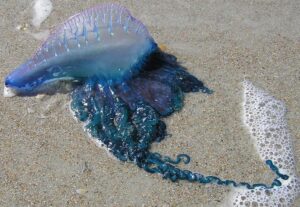 Jellyfish and Portuguese Man of War have been spotted along the surrounding area beaches already this season and the little floating creatures can pack a punch. Often times beachgoers will spot them washed up on shore and other times they can be spotted in the water, but it is best to avoid them when you can. “While all jellyfish sting, not all contain poison that hurts humans. Be careful of jellies that wash up on shore, as some can still sting if tentacles are wet. NOAA recommends that if you are stung by a jellyfish to first seek a lifeguard to give first aid. If no lifeguards are present, wash the wound with vinegar or rubbing alcohol,” NOAA suggests. And what about that … other method of treating stings? Turns out, it’s a myth. In fact, urine can actually aggravate the stinging cells of jellyfish, making things worse. These cells, which detach and stick into the skin of prey, can continue to inject venom. Urine, as well as fresh water, can cause an imbalance to the salt solution surrounding the stinging cells, causing them to continue to fire. According to Scientific American, if you don’t have vinegar or rubbing alcohol, rinsing with saltwater may be your best bet.
Jellyfish and Portuguese Man of War have been spotted along the surrounding area beaches already this season and the little floating creatures can pack a punch. Often times beachgoers will spot them washed up on shore and other times they can be spotted in the water, but it is best to avoid them when you can. “While all jellyfish sting, not all contain poison that hurts humans. Be careful of jellies that wash up on shore, as some can still sting if tentacles are wet. NOAA recommends that if you are stung by a jellyfish to first seek a lifeguard to give first aid. If no lifeguards are present, wash the wound with vinegar or rubbing alcohol,” NOAA suggests. And what about that … other method of treating stings? Turns out, it’s a myth. In fact, urine can actually aggravate the stinging cells of jellyfish, making things worse. These cells, which detach and stick into the skin of prey, can continue to inject venom. Urine, as well as fresh water, can cause an imbalance to the salt solution surrounding the stinging cells, causing them to continue to fire. According to Scientific American, if you don’t have vinegar or rubbing alcohol, rinsing with saltwater may be your best bet.
At the beach? Don’t pop the ‘balloons!’
We’ve definitely had some windy weather in the past few days. And on the coast, those winds bring with it an interesting sighting! The Cape Lookout National Seashore Park posted on Facebook about some very temptingly poppable-looking things that have been washing up on their beaches. These little “balloons” are gas-filled floats that keep the Man-o-War jellyfish afloat as they drift through the ocean. The winds can pick these floats up and they can wind up on the beach, but the folks at the park caution that no matter how tempting it is, you should not pop these things! “Give them a wide berth,” the Facebook post ways. These are carnivorous jellyfish and use their dangling tentacles to kill their prey. Even washed ashore, the tentacles still pack a punch, so don’t mess with the balloons! Stepping on it will hurt!
Read more » click here
Portuguese man o’ war
The man-of-War are not usually in the area unless pushed to the coast by wind and ocean currents. It is a purple-blue color and can be up to 10 inches long. The Portuguese man o’ war (Physalia physalis), is not a jellyfish but related to the species and is highly venomous. It has numerous venomous microscopic nematocysts which deliver a painful sting powerful enough to kill fish. Stings can result in intense joint and muscle pain, headaches, shock, collapse, faintness, hysteria, chills, fever, nausea, and vomiting. Severe stings can occur even when the animal is beached or dead. Although it superficially resembles a jellyfish, the Portuguese man o’ war is in fact a siphonophore. Like all siphonophores, it is a colonial organism, made up of many smaller units called zooids. All zooids in a colony are genetically identical, but fulfill specialized functions such as feeding and reproduction, and together allow the colony to operate as a single individual.

 Staying safe at the beach: Rip currents, jellyfish, sharks, and other hazards
Staying safe at the beach: Rip currents, jellyfish, sharks, and other hazards
A trip to the beach can turn deadly (or painful) due to natural hazards but being aware of risks and mitigating hazards is a good way to prevent problems.
Picture this: warm weather, blue skies, and your toes in the sand — it sounds like a perfect lazy summer day at the beach. Maybe you decide to cool down in the ocean and find yourself bobbing around when suddenly you realize you are a little too far out. As panic sinks in and you start to swim towards dry land you realize your efforts are in vain and your whole body is getting tired, all the while you are drifting further into the Atlantic — you have gotten stuck in a rip current. It’s not the only potential danger in the ocean, though. There are also sharks. And, of course, there are some things on shore that ruin your day at the beach, too, including stepping on jellyfish and, of course, good old-fashioned sunburn.
Rip currents
According to the U.S. Lifesaving Association (USLA), 80 percent of all ocean rescues are related to rip currents and annually more than 100 fatalities across the country are due to rip currents. While it is obvious that swimming at a beach with lifeguards is one of the safer options, there are plenty of area beaches that lack lifeguards or maybe ocean rescue season has not started just yet. So, what is the best course of action for surviving a rip current? According to the National Weather Service, there are several things swimmers should keep in mind when dealing with these often-unseen dangers.
- Relax. Rip currents don’t pull you under.
- A rip current is a natural treadmill that travels an average speed of 1-2 feet per second but has been measured as fast as 8 feet per second — faster than an Olympic swimmer. Trying to swim against a rip current will only use up your energy; energy you need to survive and escape the rip current.
- Do NOT try to swim directly into to shore. Swim along the shoreline until you escape the current’s pull. When free from the pull of the current, swim at an angle away from the current toward shore.
- If you feel you can’t reach shore, relax, face the shore, and call or wave for help. Remember: If in doubt, don’t go out!
- If at all possible, only swim at beaches with lifeguards.
- If you choose to swim on beaches without a lifeguard, never swim alone. Take a friend and have that person take a cell phone so he or she can call 911 for help.
Sharks
Sharks are a fear on most every swimmer’s mind, regardless of the actual dangers posed by the large predatory fish. “NOAA states that while shark attacks are rare, they are most likely to occur near shore, typically inshore of a sandbar or between sandbars where sharks can be trapped by low tide, and near steep drop-offs where sharks’ prey gather. While the risks are small, it’s important to be aware of how to avoid an attack,” according to previous reporting.
Suggestions from NOAA for reducing the risk of a shark attack include:
- Don’t swim too far from shore.
- Stay in groups – sharks are more likely to attack a solitary individual.
- Avoid being in the water during darkness or twilight when sharks are most active.
- Don’t go in the water if bleeding from a wound – sharks have a very acute sense of smell.
- Leave the shiny jewelry at home – the reflected light resembles fish scales.
- Avoid brightly-colored swimwear – sharks see contrast particularly well.
Sunburns
Most everyone has experienced a sunburn at one point in their life and while not often thought as a major concern for many, overexposure to UV light can cause serious long-term problems including skin cancer. The Centers for Disease Control and Prevention (CDC) recommends using at least S.P.F. 15 sunscreen at least 15 minutes prior to sun exposure. Wearing a hat, long sleeves, and other protective clothing is also recommended to keep skin protected.
Jellyfish
Jellyfish and Portuguese Man of War have been spotted along the beaches of New Hanover County and surrounding area beaches already this season and the little floating creatures can pack a punch. Often times beachgoers will spot them washed up on shore and other times they can be spotted in the water, but it is best to avoid them when you can. “While all jellyfish sting, not all contain poison that hurts humans. Be careful of jellies that wash up on shore, as some can still sting if tentacles are wet. NOAA recommends that if you are stung by a jellyfish to first seek a lifeguard to give first aid. If no lifeguards are present, wash the wound with vinegar or rubbing alcohol,” NOAA suggests. And what about that … other method of treating stings? Turns out, it’s a myth. In fact, urine can actually aggravate the stinging cells of jellyfish, making things worse. These cells, which detach and stick into the skin of prey, can continue to inject venom. Urine, as well as fresh water, can cause an imbalance to the salt solution surrounding the stinging cells, causing them to continue to fire. According to Scientific American, if you don’t have vinegar or rubbing alcohol, rinsing with salt water may be your best bet.
Read more » click here

How to Collect Seashells
“It helps to have a search image in your mind,” says José H. Leal, the science director and curator at the Bailey-Matthews National Shell Museum in Florida. Research ahead of time what kind of mollusks you might encounter so that your eyes are primed to pick out specific shapes and colors. Leal has collected seashells since he was a boy in Rio de Janeiro. On his first trip to New York, in his 20s, he was so shell-focused that he dove to the sidewalk before realizing that what he thought were small, unusual clams were actually pistachio shells. “You get fixated,” he says. Consult a tide chart; go out within an hour of low tide when the beach is most exposed. Storms tend to wash more shells ashore in the winter months. In popular shelling destinations such as Sanibel Island, near where Leal lives, collectors often search at night to avoid competition. (If turtles are nesting in the area, avoid using flashlights, which disrupt brooding females and disorient their hatchlings.) If shells are abundant, pick a spot and settle in. Rather than hoard shells, take only the most beautiful specimens of each variety. Make sure the shell is uninhabited. With the spiral-shaped gastropods, you should be able to see the creature. “A shell is usually much heavier when there’s an animal inside,” Leal says. Know the relevant regulations; many places curtail or outright ban the collection of shells, and the United States has various import restrictions, including a prohibition on queen conch shells from the Caribbean. The urge to beachcomb is natural, however. Humans have been using mollusk exoskeletons as art, adornment, currency, and tools since before we were even human beings. (Scientists recently discovered distinct hash marks on a freshwater mussel shell they believe were engraved by our extinct ancestor Homo erectus.) Still, Leal is worried about the future of marine mollusks, given how vulnerable they are to pollution and ocean acidification. Maybe your urge to collect these unoccupied calcium-carbonate dwellings can serve as a sort of gateway drug. “Once you get a love for shells,” Leal says, “I hope you learn to care about the animals that make them.”
Read more » click here
Coyotes –

Keeping your pets safe as coyote sightings increase ahead of pup season
Biologists with the N.C. Wildlife Resources Commission say this month is when people are more likely to spot a coyote than any other time of year. Coyotes are common throughout North Carolina, including in cities and suburbs, but often go unnoticed because they are skilled at avoiding people. In late spring, however, coyote parents are busy raising their young pups, which means more hours scouting for food and more opportunities for people to catch a glimpse of one. Coyotes will roam a large area, crossing through neighborhoods and business districts, looking for an easy meal. Coyotes mostly eat rodents, rabbits, insects, fruit, and carrion, but will also dine on pet food and table scraps left outside. Seeing a coyote in a residential area shouldn’t cause alarm, as attacks on humans are very rare, and coyotes actually help to keep rodent populations in check. However, concerns for small pets, such as cats and small-breed dogs, may be valid as these animals can easily be mistaken for a coyote’s natural prey. For this reason, small pets should always be closely supervised when outdoors, or kept behind a dog-proof fence that is at least 6 feet tall and prevents digging underneath. “Using a 6-foot leash is an excellent way to protect small pets when they’re outside,” advises Falyn Owens, extension biologist for the Wildlife Commission. “If you notice a coyote watching or following you during a walk, pick up your pet and haze the coyote until it leaves. Your physical presence can be a powerful deterrent for a curious coyote.” In neighborhoods, residents can make the area less attractive to coyotes by removing easy food sources and actively scaring off any coyotes they see. Teaching a coyote to have a healthy fear of people is a great way to discourage unwanted behavior and foster coexistence.
Read more » click here
State Wildlife Resources Commission: Expect coyote sightings
The North Carolina Wildlife Resources Commission says people should expect coyote sightings the rest of the spring. The NCWRC says coyotes are common throughout the state, even in cities and suburbs, but frequently are not seen because they are adept at avoiding people. The commission says coyotes prefer to raise their young in secluded areas, but the animals must scout for food all over to feed their pups. Thus, people may find coyotes roaming around their neighborhoods looking for food. The NCWRC gave tips to people on how to keep themselves and their families and pets safe in the coming months:
- Keep small pets indoors or supervise them outdoors, and remove dishes and spilled food outside
- Have dog-proof fencing, which is at least six feet tall and prevents digging underneath, to keep coyotes out
- Remove any food sources that could attract coyotes (keep fruit and birdseed off the ground)
- Find ways to actively make the area uncomfortable for coyotes
- Deter coyotes away from homes and businesses by waving your arms and shouting forcefully
Visit here to learn more about how to stay away from, and if needed, deal with coyotes.
Read more » click here
Expect Coyote sightings as pupping season peaks
Coyotes will roam a wide area searching for food, sometimes crossing through neighborhoods and densely populated areas looking for an easy meal.
Coyotes are common throughout North Carolina, even in cities and suburbs, but often go unnoticed because they are very good at avoiding people. However, biologists with the N.C. Wildlife Resources Commission say that coyote sightings spike in the spring, so it’s imperative to know what attracts them, and what to do if you see one. Coyotes prefer to raise their young in secluded areas but keeping a litter of pups well-fed and healthy means scouting for food at all hours and covering a large territory. Coyotes will roam a wide area searching for food, sometimes crossing through neighborhoods and densely populated areas looking for an easy meal. Coyotes mostly eat rabbits, small rodents, insects, fruits and dead animals, but will also dine on outdoor pet food and food scraps left near homes. Smaller pets, such as cats and small-breed dogs, should always be closely supervised when outdoors, as they can easily be mistaken for a coyote’s natural prey. Dog-proof fencing, which is at least 6 feet tall and prevents digging underneath, is the only guarantee of a no-coyote zone, but there are other ways to keep coyotes from hanging around. “Try to remove any food sources that could attract coyotes and find ways to actively make the area uncomfortable for them,” says Falyn Owens, extension biologist for the Wildlife Commission.
Owens offers these tips to deter coyotes:
- Feed pets inside and keep food waste in secure containers. If you feed pets outside, set specific feeding times and remove the dishes and spilled food afterward.
- Keep fruit and bird seed off the ground. They can attract coyotes and their rodent prey.
- Keep cats and small dogs on a leash or harness whenever they are outside.
- Haze coyotes away from homes and businesses. Examples include waving your arms and shouting forcefully until a coyote leaves, spraying them with a water hose or throwing small rocks in their direction.
Pup season brings an added factor to interacting with coyotes. “Coyotes typically avoid confrontations with people, but they are diligent parents. A coyote that has young pups nearby is more likely to stand its ground rather than run away. If you are passing through a brushy or wooded area and notice a coyote watching you or following you at a distance, there could be a den nearby,” said Owens. “Calmly leave and notify others to avoid the area if you are near a public trail. Coyotes will move on once their pups are old enough to survive outside of the den.” Coyotes rarely attack people, but sometimes take an interest in our pets. Keep cats indoors, and if you are walking a small dog and notice a coyote watching or following you, pick up the dog and haze the coyote until it leaves. Teaching a coyote to have a healthy fear of people is a great way to discourage unwanted behavior and foster coexistence. If you have questions about interactions with coyotes, you can click here to be directed to the N.C Wildlife Commission’s website.
Read more » click here
Snakes –
 As snake sightings increase due to warmer weather,
As snake sightings increase due to warmer weather,
NC Wildlife urges people not to kill them
The warm weather means more snakes will start to show up along trails, in the woods, crossing roads and in our yards, according to the NC Wildlife Resources Commission. Wildlife diversity biologists request that if you see a snake, do not be alarmed, do not kill it, give it plenty of room, and if you see a rattlesnake, report it. “Snakes are an important part of the ecosystem and help control the rodent, slug and insect populations,” reptile conservation biologist Jeff Hall said. “There are many ways we can coexist with snakes, which is important because of 38 of North Carolina’s native snake species, ten are listed endangered, threatened or of special concern.” Of the six venomous snake species native to N.C., three are rattlesnakes – the timber, the pigmy and the Eastern diamondback. Each one is in decline and protected by the North Carolina Endangered Species Act. Persecution by humans and habitat destruction are the main culprits. If anyone spots a rattler, they are urged to send an email to [email protected] with a photo (required), date and time the snake was observed and location (GPS coordinates preferred), or they can log their sighting on the HerpMapper mobile app. If you see a snake in your yard and would prefer it to reside elsewhere, NC Wildlife says you can safely encourage it to leave by gently spraying it with a garden hose. You can also make your yard less hospitable for snakes by cleaning up clutter such as stick and rock piles, keeping your lawn mowed, closing gaps and holes in your siding and foundation, and sealing openings under doors, windows and around waterpipes. They say most snakes will leave people alone if they aren’t bothered and are provided an escape route. Watching for snakes and giving them a wide berth are effective habits for co-existing with snakes safely.
Read more » click here
There are 6 venomous snakes in North Carolina. Know what they look like.
If it’s spring, it’s time for us to remind you about some of the slithering neighbors you might encounter when you’re outdoors over the next several months. As the weather warms up in North Carolina, snakes start moving around, doing snakey things, and we are more likely to cross paths with them. They generally aren’t cause for much concern, but encounters can be a little scary for some (for the snakes as well as the people). It’s important to know that of the 38 species of snakes in North Carolina, the majority are nonvenomous and not aggressive toward people unless threatened. Arm yourself with knowledge. Learn about the venomous (sometimes incorrectly referred to as poisonous) snakes in our area, and how to distinguish them from the harmless ones.
How to tell if a snake is venomous
What’s the head shape? A commonly shared rule of thumb is that most venomous snakes have a triangular or diamond-shaped head, while nonvenomous snakes have a tapered head.
You can’t rely on that, though. Some nonvenomous snakes (such as a rat snake) can mimic the triangular shape of venomous snakes by flattening their heads when threatened (to avoid becoming the prey of another animal), so never go by head shape alone.
Can you see its eyes? Another tricky but often shared tip is to check out the pupil shape. Venomous snakes have been said to have oblong pupils that look like a slit in the center of the eye, whereas nonvenomous snakes will have a round pupil. In fact, according to a document on the NC Wildlife website, a snake’s pupils can dilate just like a human’s, and can look round.
The best way to know if a snake is venomous is to know which venomous snakes are common in your area and know what they look like.
North Carolina’s venomous snakes
There are six venomous snakes found in North Carolina:
- The copperhead
- The cottonmouth (also called water moccasin)
- The Eastern diamondback rattlesnake
- The timber rattlesnake
- The pigmy rattlesnake
- The Eastern coral snake
Copperhead
Copperhead snakes are the most common venomous snakes in North Carolina.
What they look like: They are brownish in color with an hourglass shaped pattern, which resembles a Hershey Kiss. Copperhead babies are born with a yellow or green tail tip, which turns brown or black after they are about a year old. Adult copperheads grow to about 3 feet long.
The bite: The Carolinas Poison Center in Charlotte says it receives about 10 times the number of calls about copperhead bites than all other snakes combined. Copperhead bites can be severe, but about half of copperhead bites result in only mild swelling and pain.
Where are they? Copperheads are found all over North Carolina.
(Source: Carolinas Poison Center)

Cottonmouth (water moccasin)
What they look like: Cottonmouth snakes have dark bands on dark or olive skin, but are most well-known for the white, cotton-like interior of their mouths.
Young cottonmouths can be lighter in color and can resemble copperheads. Juvenile cottonmouths have bright yellow or greenish tail tips, and the details of the cross-band pattern are most evident in this age group. Older cottonmouth snakes are often completely dark and with no pattern.
Adult cottonmouths grow to about 3-4 feet in length but have been known to grow to 6 feet.
The bite: The bite severity of a cottonmouth is similar to that of a copperhead.
Where are they? Cottonmouths are found mostly in the eastern part of North Carolina and prefer freshwater environments (but can also be found on land).
(Source: Carolinas Poison Center)

Eastern diamondback rattlesnake
What they look like: The eastern diamondback rattlesnake has gray or yellowish skin with a dark diamond pattern outlined in black. They have large, broad heads with two light lines on the face.
The Eastern diamondback rattlesnake is the heaviest, though not the longest, venomous snake in the Americas, and it is the largest rattlesnake in the world. These snakes can weigh up to four or five pounds and typically grow to about 4-5 feet in length (the largest ever recorded was 8 feet long).
These snakes are known for the bone-chilling rattle sound they make.
The bite: Bites from rattlesnakes are more severe than bites from copperheads or cottonmouths, and are considered a medical emergency.
Where are they? They are found in the southeastern parts of North Carolina, preferring sandy, coastal regions.
(Source: Carolinas Poison Center, Savannah River Ecology Lab)

Pigmy rattlesnake
What they look like: Pigmy rattlesnakes have gray, pinkish or red skin with a dark, spotted pattern. They grow only to about 1-2 feet in length.
Pigmy rattlesnakes do rattle, but the rattle sounds more like a buzz.
The bite: Bites from rattlesnakes are more severe than copperheads or cottonmouths and are considered a medical emergency.
Where are they? These snakes are found in the southeastern part of North Carolina, particularly in forests.
(Source: Carolinas Poison Center)

Timber rattlesnake
What they look like: The timber rattlesnake can vary in color but has dark bands on lighter skin with a rattle at the end of its tail. Coastal varieties have what looks like a brown or orange “racing stripe” down the middle of the back.
Timber rattlesnakes grow to about 4 feet in length.
The bite: Bites from rattlesnakes are more severe than copperheads or cottonmouths and are considered a medical emergency.
Where are they? Timber rattlesnakes can be found throughout North Carolina, preferring forests.
(Source: Carolinas Poison Center)

Eastern coral snake
Coral snakes are actually extremely rare in North Carolina and are considered endangered, but they are quite venomous.
What they look like: These snakes are slender with red, yellow, and black rings. The coral snake closely resembles the scarlet kingsnake (which is harmless), but there’s an easy way to tell them apart. Just remember this rhyme: “Red touches black, friend of Jack; red touches yellow, kills a fellow.”
Another way to tell a scarlet kingsnake from a coral snake is by the color of its snout. A scarlet kingsnake has a red snout, and a coral snake has a black snout.
A coral snake’s snout is also blunt shaped, especially compared to most snakes.
The bite: Coral snake venom attacks the central nervous system, and death, if it occurs, is usually the result of respiratory failure.
Where are they? Coral snakes live in sandy areas nearer the South Carolina border and stay underground most of the time.
(Source: Herps of NC)

If you have been bitten by a snake, you SHOULD:
▪ Sit down and stay calm.
▪ Gently wash the bite area with warm, soapy water.
▪ Remove any jewelry or tight clothing near the bite site.
▪ Keep the bitten area still, if possible, and raise it to heart level.
▪ Call the Carolinas Poison Center: 1-800-222-1222.
Note: If a snakebite victim is having chest pain, difficulty breathing, face swelling or has lost consciousness, call 911 immediately.
If bitten by a snake, you SHOULD NOT:
▪ Cut the bitten area to try to drain the venom. This can worsen the injury.
▪ Ice the area. Icing causes additional tissue damage.
▪ Apply a tourniquet or any tight bandage. It’s actually better for the venom to flow through the body than for it to stay in one area.
▪ Suck on the bite or use a suction device to try to remove the venom.
▪ Attempt to catch or kill the snake.
Call Carolinas Poison Center at 1-800-222-1222 for questions about a snake bite or for more information.
(Source: Carolinas Poison Center)
Read more » click here
Hot Button Issues –
Subjects that are important to people and about which they have strong opinions

Climate
For more information » click here
There’s something happening here
What it is ain’t exactly clear
Heat Will Likely Soar to Record Levels in Next 5 Years, New Analysis Says
The News
Global temperatures are likely to soar to record highs over the next five years, driven by human-caused warming and a climate pattern known as El Niño, forecasters at the World Meteorological Organization said on Wednesday. The record for Earth’s hottest year was set in 2016. There is a 98 percent chance that at least one of the next five years will exceed that, the forecasters said, while the average from 2023 to ’27 will almost certainly be the warmest for a five-year period ever recorded. “This will have far-reaching repercussions for health, food security, water management and the environment,” said Petteri Taalas, the secretary general of the meteorological organization. “We need to be prepared.”
Why It Matters: Every fraction of a degree brings new risks.
Even small increases in warming can exacerbate the dangers from heat waves, wildfires, drought and other calamities, scientists say. Elevated global temperatures in 2021 helped fuel a heat wave in the Pacific Northwest that shattered local records and killed hundreds of people. El Niño conditions can cause further turmoil by shifting global precipitation patterns. The meteorological organization said it expected increased summer rainfall over the next five years in places like Northern Europe and the Sahel in sub-Saharan Africa and reduced rainfall in the Amazon and parts of Australia. The organization reported that there is also a two thirds chance that one of the next five years could be 1.5 degrees Celsius, or 2.7 degrees Fahrenheit, hotter than the 19th-century average. That does not mean that the world will have officially breached the aspirational goal in the Paris climate agreement of holding global warming to 1.5 degrees Celsius. When scientists talk about that temperature goal, they generally mean a longer-term average over, say, two decades in order to root out the influence of natural variability. Many world leaders have insisted on the 1.5-degree limit to keep the risks of climate change to tolerable levels. But nations have delayed so long in making the monumental changes necessary to achieve this goal, such as drastically cutting fossil-fuel emissions, that scientists now think the world will probably exceed that threshold around the early 2030s.
Background: La Niña, a cooling influence, is on the way out.
Global average temperatures have already increased roughly 1.1 degrees Celsius since the 19th century, largely because humans keep burning fossil fuels and pumping heat-trapping gases like carbon dioxide into the atmosphere. But while that overall upward trend is clear, global temperatures can bounce up and down a bit from year to year because of natural variability. For instance, a cyclical phenomenon in the Pacific Ocean, the El Niño-Southern Oscillation, causes year-to-year fluctuations by shifting heat in and out of deeper ocean layers. Global surface temperatures tend to be somewhat cooler during La Niña years and somewhat hotter during El Niño years. The last record hot year, 2016, was an El Niño year. By contrast, La Niña conditions have dominated for much of the past three years: while they’ve been unusually warm, they were still slightly below 2016 levels. Now, scientists are expecting El Niño conditions to return later this summer. When combined with steadily rising levels of greenhouse gases in the atmosphere, that will most likely cause temperatures to accelerate to new highs.
Read more » click here
Global temperatures could soon briefly breach climate threshold, scientists warn
The World Meteorological Organization virtually guarantees that one of the next five years will be the warmest on record, announcing Wednesday that a developing El Niño pattern will overlap with worsening human-caused climate change to push Earth’s temperatures into uncharted territory. While Earth’s temperatures have fluctuated wildly over its 4.5 billion year history, it’s well established that human emissions are accelerating warming at a breakneck pace, the rapidity of which is distinct from natural processes. Experts at the World Meteorological Organization (WMO) anticipate that global temperatures at some point in the next five years will, at least temporarily, spike above the 1.5 degree Celsius (2.7 degree Fahrenheit) benchmark outlined in the Paris Climate Accords, an agreement signed by 196 countries at the United Nations Climate Change Conference on Dec. 12, 2015. That 1.5 degree Celsius number is compared to preindustrial levels. “WMO is sounding the alarm that we will breach the 1.5 [degree Celsius] level on a temporary basis with increasing frequency,” said WMO secretary general Prof. Peter Taalas in a news release. Although the WMO suggests the global temperature could temporarily reach that level, separate analyses have previously suggested a more permanent arrival above the 1.5 degree Celsius threshold is more likely to arrive in the 2030s. The WMO suggests there’s a 1 in 3 chance that it will occur in the next five years.
What the WMO is predicting
The World Meteorological Organization is warning of the following:
- A 66 percent chance, or roughly 2 out of 3 odds, that Earth’s global temperature exceeds the 1.5 degree Celsius (2.7 degree Fahrenheit) above preindustrial levels benchmark at least once in the next five years.
- A 98 percent likelihood, or essentially a guarantee, that at least one of the next five years will go down as Earth’s warmest on record. Records date back to around 1850.
- There is also a 98 percent chance that the upcoming five-year block, 2023 to 2027, could average as the hottest five-year window on record. (The past eight years were the eight warmest on record.)
- Heating of the Arctic is predicted to triple average warming globally. Some peer-reviewed research indicates that a disproportionate warming of the poles can increase the amplitude, or waviness, of the jet stream, leading to more extreme weather patterns. There is also research to suggest reduced periodicity of the jet stream, or a slowing of its west-to-east propagation. That allows weather patterns to become “stuck” for longer.
Climate change and El Niño overlap
The past three years have featured a “triple dip” La Niña, or a global weather pattern born from a cooling of the waters in the eastern tropical Pacific. That fostered sinking motion in the air over the Pacific, in turn allowing rising motion and enhanced hurricane seasons in the Atlantic. Now meteorologists are anticipating a flip-flop, with an abrupt warm-up of waters in the eastern Pacific. The Climate Prediction Center at the National Weather Service predicts an 80 percent chance of a moderate El Niño developing in the coming months, with a 55 percent likelihood it will be “strong.” There’s also a 90 percent shot it sticks around into the Northern Hemisphere’s winter months. Earth’s temperature is known to warm during an El Niño. That’s why scientists are concerned about it exacerbating the effects of climate change, which continue to grow. For six of the past seven decades, the warmest year of each of said decades was an El Niño year. That’s why it’s highly probable that at least one of the next several years, which will inevitably feature an El Niño, will be catapulted above the 1.5 degrees Celsius threshold.
Fitting into a larger pattern
Since 1850, or before the Industrial Revolution, global temperatures have warmed about 1.1 degree Celsius, or about 2 degrees Fahrenheit. That may seem inconsequential, but subtle changes in temperature can have cascading ripple effects on the fundamental behaviors of the atmosphere and the innumerable land, water, ice and ecological cycles that interact with it. For each degree Fahrenheit the air temperature warms, the air can hold 4 percent more water. (For each degree Celsius, it can hold 7 percent more water.) That means temperature rises are accompanied by an exponential increase in the atmosphere’s moisture-storing capacity. Where moisture is available, flooding rains are becoming increasingly common. Where and when it’s not, drought is becoming more severe and more deeply entrenched. The warming climate has also been tied to more extreme wildfire behavior and increased areal coverage of land burned, stronger and more rapidly intensifying tropical cyclones/hurricanes, cold-season tornado outbreaks and a litany of other hazards. While 2016, an El Niño year, still holds the record for the warmest year catalogued by WMO data sets, the past eight years are the eight warmest on record. While it’s impossible to say with certainty where 2023 will end up, the year is already off to an alarming start. The National Oceanic and Atmospheric Administration has said there’s a greater than 1 in 4 chance that 2023 becomes the new warmest year on record, and a 9 out of 10 chance of it being a top-five year. After setting a record in 2022, for example, global ocean temperatures are running 0.1 to 0.2 degrees Celsius higher than ever observed by satellites this time of year. That’s mirrored by record global ocean heat content — a known fuel for strong hurricanes. In just the past few weeks, air temperature records have abounded worldwide. That’s been especially true in Southeast Asia, one of the most densely populated places in the world. On May 6, Luang Prabang in Laos made it to 110.3 degrees, beating out its 108.9-degree all-time record set just last month. Vietnam also broke a national heat record, hitting 111.6 degrees in Tuong Duong. Bangkok got to 104.9 degrees, its all-time record, and Cambodia, as well as parts of China, set records for the month of May. Heat records have been smashed in the U.S. Pacific Northwest and historic wildfires are burning unusually early in British Columbia and Alberta, Canada, suffocating the city of Calgary in a toxic orange shroud. And on Wednesday, 35 weather stations in Japan logged their hottest May day on record. Each of the events is made more likely and intense by the effects of human influence.
Read more » click here
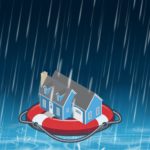
Flood Insurance Program
For more information » click here
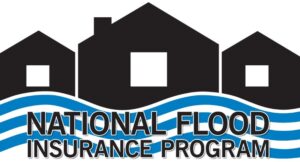
National Flood Insurance Program: Reauthorization
Congress must periodically renew the NFIP’s statutory authority to operate. On December 23, 2022, the President signed legislation passed by Congress that extends the National Flood Insurance Program’s (NFIP’s) authorization to September 30, 2023.
Congress must now reauthorize the NFIP
by no later than 11:59 pm on September 30, 2023.
FEMA Releases New Flood Insurance Rates by ZIP Code. Brace for Impact.
When the Federal Emergency Management Agency unveiled its new Risk Rating 2.0 methodology for calculating flood insurance, advocates and critics alike warned that it would mean higher premiums for thousands of property owners, especially in low-elevation coastal areas. Now, the full impact of the sticker shock is becoming clear, thanks to new data released by FEMA that shows price increases – and decreases – by county and by ZIP codes. But some spots will see decreases under RR 2.0, which is based less on FEMA’s much-criticized flood maps and more on a multitude of factors, including rainfall levels, elevation, a home’s distance from water, and rebuilding costs. Existing property owners won’t feel the pain all at once. Federal law limits the rate increases to no more than 18% annually on renewals. For people buying new policies, though, the full impact will be painfully obvious. For the past year, FEMA has required new policies to be rated under RR 2.0. He also noted that some prospective home buyers may not be aware of the soaring premiums. If the seller doesn’t explain about the new rating system, which grandfathers in existing owners, buyers could easily assume that their rates will remain the same.
The FEMA spreadsheet with all U.S. ZIP codes can be downloaded here.
Read more » click here

GenX
For more information » click here

Homeowners Insurance
For more information » click here
Your Homeowners’ Insurance Bill Is the Canary in the Climate Coal Mine
If you don’t think you’ve been affected by global warming, take a closer look at your last homeowners’ insurance bill: The average cost of coverage has reached $1,900 a year nationwide, but it’s $4,000 a year in New Orleans and about $5,000 a year in Miami, according to Policygenius, an online insurance marketplace. And that is pocket change compared with the impact climate change may ultimately have on the value of your home. We have reached a turning point: Climate risk is driving insurer decisions like never before. After recent years of paying out claims for about 20 disasters a year with damages of over $1 billion, a sixfold increase from the 1980s, insurers are getting serious about new pricing models that incorporate the costs of a warming climate. Across the United States, premiums jumped 12 percent from 2021 to 2022, according to Policygenius estimates, and they are expected to continue to rise. Even with higher premiums, unpredictable losses are wreaking havoc on insurers’ bottom lines. Ten insurers have gone belly up in Florida in just the last two years. And in many cases, insurers are pulling back in risky areas, leaving state-backed insurance plans holding the bag. Both private and government-backed insurers are undercapitalized for dealing with the potentially massive disasters we could be facing in coming years. This shortfall foreshadows more premium increases, which will drag down house prices. And losses will not be borne by those residing in higher-risk areas only; they will be borne by policyholders everywhere. Thus far, housing markets have largely managed to ignore these potential exposures. Over the last three years, home prices are up around 37 percent nationwide. They are up even more in parts of Florida and the Southwest that are predicted to suffer significant impacts from a warming climate. Take Phoenix, which, by 2060, is forecast to endure 132 days each year with temperatures of over 100 degrees. Last summer, the water level in Lake Mead, a critical source of water for 25 million people in the Southwest, reached its lowest level since the reservoir was filled in 1937. And living in Phoenix requires energy-intensive amenities like air conditioning, which worsen these consequences. Yet Phoenix home prices are up 53 percent since January 2020. Why are so many home buyers putting themselves in harm’s way? The simplest explanation is that they are choosing to focus on the short-term benefits of sunny weather rather than the longer-term problems. A defining feature of the pandemic housing boom has been Americans, particularly retirees, moving southward. And with about 10,000 Americans turning 65 each day, this pattern could continue for years to come. It’s hard to make decisions based on things we haven’t experienced. But by ignoring the growing consequences of climate change, we are investing too much in potentially hazardous areas in a way that’s hard to unwind. In 50 years, the result could be miles of unlivable homes along waterfronts and in deserts. The financial consequences of these choices will be enormous, causing ripple effects through insurance markets and ultimately undermining home values. Climate risks are difficult to forecast and are increasingly correlated: From insurers’ perspectives, it’s “Everything Everywhere All at Once,” with heightened risks of floods, droughts, wildfires and more. To have the necessary buffer to pay out claims after catastrophic losses, insurers will need more reserves and more reinsurance, and they will pass those costs on to policyholders in the form of higher premiums. That includes policyholders who live well out of harm’s way. The year after the Marshall fire destroyed over 1,000 homes and caused over $2 billion in damage near Boulder, Colo., average premiums rose over 17 percent statewide. While insurers can choose to stop offering insurance, the homeowners and governments they leave behind will still have to deal with the risks. And as the costs go up, more households may decide to reduce their coverage or may choose to go without insurance entirely. It’s estimated that only one-third of households in flood zones have flood insurance — with many risking financial ruin if the “big one” hits. Then there’s the housing market. There is $30 trillion in housing equity in the United States, and the most important source of wealth for most American households is the home. If homeowners have to pay more in premiums, can’t obtain insurance at all or can’t find buyers because of fears about climate change, property values can erode or collapse even without a hurricane making landfall. This dynamic has already started: My research partner Philip Mulder and I found that low-lying housing markets in coastal Florida began to price sea level risk in the 2010s, leading to a roughly 5 percent discount relative to houses in similar, but less exposed, communities. Climate risks are disproportionately borne by lower-income groups and racial minorities, who may already live in riskier areas, are less likely to be insured, and may lack access to resources for pre-disaster preparation or post-disaster repairs. As some private insurers retreat from higher-risk areas, state-backed “insurer of last resort” plans are stepping into the void. The number of enrollees in these state-backed plans rose by 29 percent between 2018 and 2021. These plans are often more expensive, they offer less coverage than private insurance options, and they face the same concerns as private insurers about their ability to pay out in the event of a crisis without burdening policyholders statewide. What can be done? The government needs to ensure that insurers, both public and private, are sufficiently capitalized to withstand significant climate-related risks. One way to start is by instituting “stress tests” for housing and property markets against climate risk. As the recent experience of Silicon Valley Bank has taught us, the balance sheets of players in the market may be weaker than previously believed, given recent swings in interest rates. If balance sheets can’t cover the losses, either claims go unpaid, or the broader population is on the hook for the difference. These stress tests should consider not only a severe natural disaster scenario, but also a sharp “revaluation” event responding to a change in climate forecasts. How would coastal housing markets respond to news that ice sheets were melting faster than anticipated, leading to more rapidly rising seas? Current homeowners and those shopping for a house need to wake up. Some will undoubtedly dismiss these risks, reasoning that the impact is likely to be “beyond their investment window.” In making that assumption, however, they are ignoring that when they sell their home, they will need to find a buyer willing to bear the uncertainty. Other homeowners prefer to avoid publicizing risks that could harm their property value, abetted by uneven disclosure requirements across states. Right now, those of us who elect to live in safer communities are quietly subsidizing those who do not. Homeowners who move to areas that are likely to be significantly impacted by climate change should pay for the potential risks they are assuming. One way to do that would be to have Fannie Mae and Freddie Mac incorporate climate risk into their pricing models. If you want to buy a waterfront home on Siesta Key, Fla., you will pay a higher interest rate on your mortgage, a surcharge you could reduce by climate-proofing your home. Note, however, that most climate proofing won’t help if, as scientists predict, the home is literally underwater. The government should manage expectations through better disclosure and better assessment of climate perils. An easy first step would be to make detailed risk data more accessible and interpretable. Potential property owners deserve loud and crystal-clear warnings of climate-related risks, especially if prices are not yet providing a sufficient signal on their own. Private insurers are sending a warning signal about heightened climate risks that homeowners and potential buyers need to receive. Insurers’ decisions are leaving households with fewer choices, less protection, and more financial distress. Homeowners should understand the potential hazards and find the right insurance policy or policies to protect them from harm. And they need to be aware that the costs of living in harm’s way are going to rise in coming years. An era of complacency is ending. If you decide to buy that condo where you can hear the ocean’s waves, realize that you are likely to pay more for that privilege — one way or the other.
Read more » click here
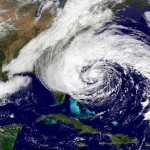
Hurricane Season
For more information » click here
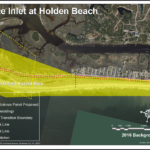
Inlet Hazard Areas
For more information » click here
.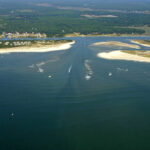
Lockwood Folly Inlet
For more information » click here.

Seismic Testing / Offshore Drilling
For more information » click here.

Offshore Wind Farms
For more information » click here
Things I Think I Think –
 Eating out is one of the great little joys of life.
Eating out is one of the great little joys of life.
Restaurant Review:
The Dinner Club visits a new restaurant once a month. Ratings reflect the reviewer’s reaction to food, ambience and service, with price taken into consideration.
///// April 2023
Name: La Cucina Italian Grill
Cuisine: Italian
Location: 1780 Chandlers Lane, Sunset Beach NC
Contact: 910.579.9777 / NA
Food: Average / Very Good / Excellent / Exceptional
Service: Efficient / Proficient / Professional / Expert
Ambience: Drab / Plain / Distinct / Elegant
Cost: $25 Inexpensive <=20 / Moderate <=26 / Expensive <=35 / Exorbitant <=60
Rating: Two Stars
La Cucina is a nice local classic Italian restaurant. Established in 2009, serving traditional Italian cuisine with a broad-based menu that offers something for everyone. It’s a comfortable, friendly, casual, environment, nothing fancy, but very welcoming and the wait staff was very accommodating. Since it’s a small busy place, with seating for only fifty (50) people, if you want to eat there you probably should call ahead for reservations. The food is very good, the portions are generous, and the prices for both the food and wine are reasonable. It’s an exceptional value, what’s not to like?

Dinner Club after 165 outings we just celebrated the major milestone
of visiting 100 different restaurants
Editor’s note –
After our pandemic hiatus we discovered that the old price guidelines were obsolete
All of our previous restaurant reviews have been updated with current menu prices

Brunswick County restaurateurs are opening a new business in a former Shallotte taproom
When the Shallotte taproom of Georgia-based brewery Red Hare closed last year, it left the Brunswick County community with one less gathering spot. It was something that the owners of the building, Stephanie and Barrett McMullan, also knew. But this couple were well positioned to bring in a replacement. They opened Wing & Fish Company a decade ago at 4764 Main St. (In fact, they celebrated the restaurant’s 10th anniversary on Sunday with a parking lot party with Mad Mole beer and Blue Shark vodka, free hot dogs and commemorative T-shirts.) They’ve since added the Ocean Isle Fishing Company and Smoke’d to their restaurant group. Now, in the former taproom at 4802 Main St., they’re planning Pour House. It’s planned to be a pay-by-the ounce, self-serve taproom with more than 30 beers on tap, Stephanie McMullan said. “We’ll also have a speakeasy style lounge upstairs with a selection of wines,” she said, as well as a bar for made-to-order cocktails. The couple are busy with their existing restaurants, but they believe Shallotte needs a place to gather for drinks, before or after dinner or a walk downtown. This concept is ideal because it doesn’t require a lot of staff, and it makes the most of its setting in the historic, 1800s-era building, McMullan said. (Its proximity to the Shallotte River meant it was used as a port for boats.) “It’s also conveniently located between Smoke’d and Wing & Fish,” she said. They’re working on renovating the space now and hope to open Pour House by Memorial Day.
Read more » click here
Closings
Chance’s Steak and Sea: Owner David Chance recently posted this restaurant at 4690 East Coast Lane in Shallotte would officially close at the end of April. His note cited the difficult labor market as one of the reasons for the closure. He added that he’s operated a restaurant at the site, originally a Golden Corral, since 2012.
Book Review:
Read several books from The New York Times best sellers fiction list monthly
Selection represents this month’s pick of the litter
/////
 LONG SHADOWS by David Baldacci
LONG SHADOWS by David Baldacci
This is the seventh installment in the Memory Man series featuring Amos Decker, an FBI consultant with the gift of a perfect memory. In the latest novel, Decker is sent to Florida with his new partner to investigate a bewildering double homicide of a federal judge and her bodyguard. It appears that the MO for both murders are different and Decker suspects that there is more than one perpetrator. Utilizing his talents toward solving murders, his memory helps him solve every case he’s given.
That’s it for this newsletter
See you next month
Lou’s Views . HBPOIN
. • Gather and disseminate information
. • Identify the issues and determine how they affect you
. • Act as a watchdog
. • Grass roots monthly newsletter since 2008

